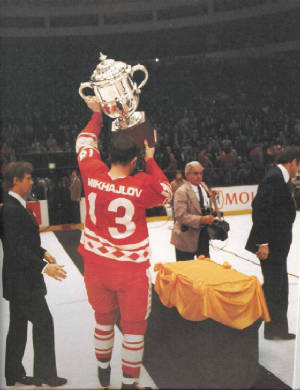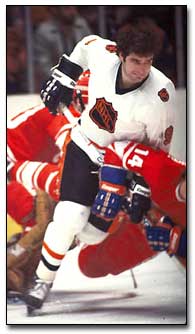|
It was the first big international meeting since the 1976 Canada Cup. The Challenge Cup was a bit different then
other series because it seemed stacked in the NHL's favor. Consider that it was in mid-season so both teams should have
been in fighting form. Add to that it was team NHL, not just team Canada, which actually meant only the addition of 3 Swedish
players to the All-Stars (Borje Salming, and former Winnipeg Jets Ulf Nilsson & Anders Hedberg). Finally, all 3 games
would be played in an NHL rink giving our boys both the home ice advantage and the smaller rink. I anticipated that
this series would stop the rapidly changing status of hockey powerhouse that had been going toward the Soviets ever since
1972.
The first game seemed to confirm that view as the NHL beat the Soviets 4-2 at Madison Square Gardens in New York City.
In fact Guy Lafleur scored 16 seconds into the first period, playing on a line with teammate Steve Shutt and Bobby Clarke.
It was Tretiak against Dryden in the nets.
Game two went two days later on February 10th, again at MSG in New York. This time however the Soviets would come out
on top 5-4. The NHL led 4-2 going into the final minutes of the 2nd period. But the Soviets pulled within one goal at 17:02
on the Power Play with Barry Beck sitting in the box.
Forty-five seconds later the Soviets not only scored the tying goal but perhaps the turn around of the series. Team NHL
would not score again in the final 4 periods of the series. That's right, the best the NHL had to offer held scoreless for
over 80 minutes of play, not just by Tretiak but also my Myshkin.
The deciding game was played on February 11th, 1979, the very next night. Knowing what we do now about the Soviets its
fair to assume that this was an advantage for the team commonly called the Red Army by Canadian fans. The Soviets single minded
purpose, lifestyle, and dry land training made them the team with the better stamina in this series.
I was 9 years old, and we had just finished a hockey game of our own. Our coach had the team and parents over to his
house to watch the final game. I remember that most of the other kids soon lost interest in the game and went off to play.
Later in the game most of the parents too had lost interest, as I continued to watch the massacre unfold.
In what shocked the hell out of me, the CCCP elected to start Myshkin in net instead of Tretiak. Why? Was it because
of the conditioning considering they were playing two straight nights? Or was it because of Tretiak's play? Perhaps just as
surprising was that Team NHL started Gerry Cheevers over Ken Dryden.
The Soviets absolutely steamrolled Team Canada. I remember watching this game as the Soviets ragged the puck from one
end of the ice to the next, making the NHL'ers look silly. You would have sworn that in the first 5 periods of this series
the Russians must have been playing possum.
After a scoreless first period the Soviets scored two goals in the 2nd, and then embarrased the NHL'ers with 4 goals
in the 3rd.
6-0
Unbelievable.
Not since the first game of the Summit Series in '72 had Canada been so humiliated. Sure this was Team NHL, not Canada,
and sure the games had been played in New York for some strange reason, but you can be certain that it was the nation of Canada
who truly felt like the losers in this series.
Myshkin had previously been thought of as a sieve, and Canadians were wringing their hands waiting for Tretiak to slow
down with age as he had been so dominant since 1972. But in this game the Soviet "backup" goalie who wore that strange cage
instead of a cool facemask like Cheevers' which was adorned with scars, stopped all 24 shots fired at him. By comparison Tretiak
had faced 40 shots and let in 8 goals (a save % of only .800).
Game #1 of the Summit Series in 1972 announced the arrival of the Soviet program inInternational hockey, but game 3 of
the Challenge Cup 8 1/2 years later would eliminate any doubt as to which nation had the best national team.
|
 |
|
|
|
 |
|
Team Rosters
NHL All-stars 1979
Guy Lafleur, Larry Robinson, Bob
Gainey, Steve Shutt, Gil Perreault, Marcel Dionne, Darryl Sittler, Lanny McDonald, Bobby Clarke, Bryan Trottier, Mike Bossy,
Clark Gillies, Barry Beck, Serge Savard, Guy Lapointe, Robert Picard, Denis Potvin, Bill Barber, Don Marcotte, Tony Esposito,
Ken Dryden, Gerry Cheevers, Ron Greschner, Borje Salming, Ulf Nilsson, Anders Hedberg
Soviet Union 1979- Sergei Starikov, Viktor Zhluktov, Vasily Pervukhin, Vladimir
Kovin, Sergei Makarov, Mikhail Varnakov, Alexander Skvortsov, Vladimir Golikov, Alexander Golikov, Boris Mikhailov, Vladimir
Petrov, Valery Kharlamov, Gennadiy Tsygankov, Valery Vasiliev, Sergei Kapustin, Yuri Federov, Zinetul Bilyaletdinov, Helmut
Balderis, Irek Gimayev, Viktor Tuminev, Sergei Babinov, Vladislav Tretiak, Vladimir Myshkin
copied from http://www.geocities.com/canadavsrussia/1976.html

|
| Not too many people were still tuned in to watch this painful ending |

|
| Clarke Gillies played the Canadian brand of the game |
|
 |
|
|
|

